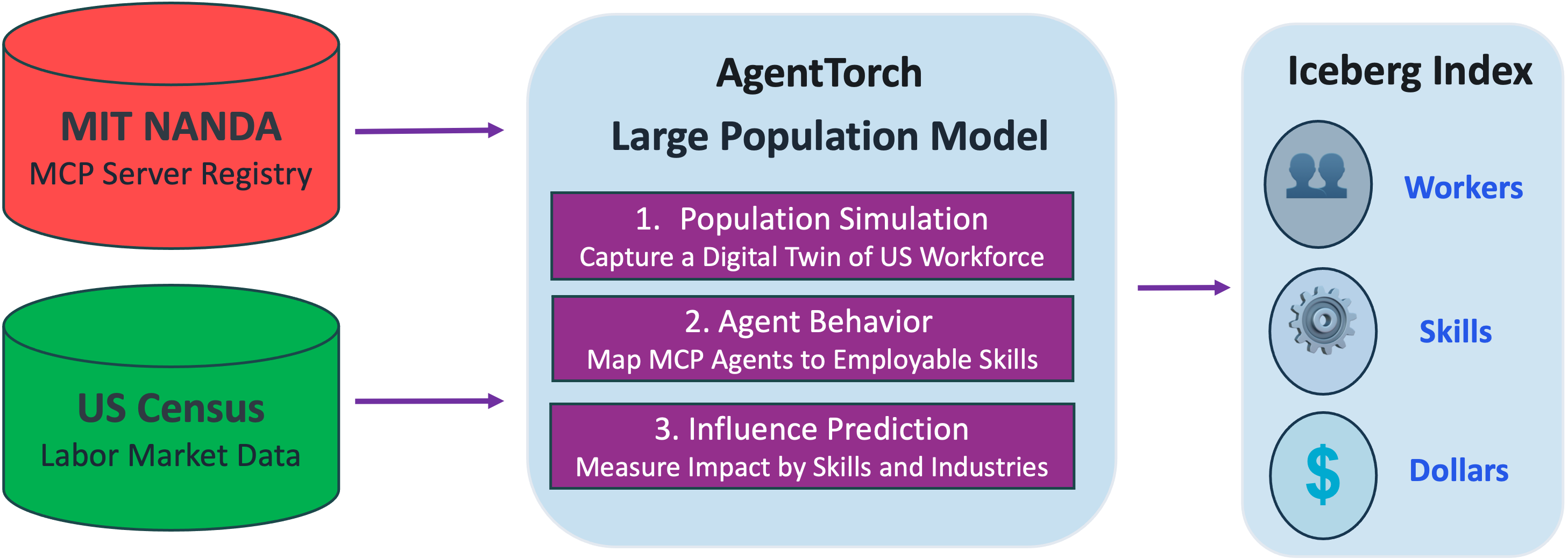The Agentic Revolution Is Already Here
Just a few months ago, Anthropic introduced the Model Context Protocol (MCP) — a new standard that allows AI models to seamlessly connect with external tools, databases, and APIs. Since then, adoption has exploded. As of March 2025, there are over 7,950 MCP servers available, with major players like Microsoft, OpenAI, and others rapidly expanding the ecosystem.
But what does this mean for our economy? What happens when AI assistants can directly access and manipulate the tools we use for work? This is the question that drives Project Iceberg.
Just as an iceberg has a visible portion above water and a much larger portion hidden beneath, our economy has visible jobs that seem immune to automation and a growing portion that's increasingly susceptible to automation through MCP and similar technologies.
The Iceberg Metaphor: Visible vs. Hidden Automation Potential
We Did the Math: The Iceberg Index
Imagine if you could simulate the entire U.S. labor market - all 151 million workers with their 32,000+ skills - and watch in real-time as AI agents reshape our economy. Which jobs would be automated first? How would the ripple effects spread across industries? What new opportunities would emerge from this transformation?
This is exactly what Project Iceberg does. Using AgentTorch's Large Population Models, we've created a digital twin of the U.S. workforce that lets us track which skills are most vulnerable to automation, quantify the economic impact, and predict how these changes will reshape society over time.
To make this complex transformation measurable, we've developed the 'Iceberg Index' — a comprehensive metric that reveals the percentage of economic value susceptible to automation through MCP-enabled AI agents
Project Iceberg Workflow: How we calculate the Iceberg Index
At Project Iceberg, we've conducted a comprehensive analysis of the U.S. labor market to quantify exactly how much of our economy is susceptible to automation through agentic AI:
Our analysis reveals two key Metrics - "Surface Index" which represents AI impact in technical skills and the "Iceberg Index" — which measures near-term influence on the percentage of white collar work currently susceptible to automation through MCP-enabled AI agents. The key insight is to consider automation of skills not jobs.
The current Surface Index is 2.27%, representing $290 billion in economic value and affecting 2.4 million workers across the U.S. economy.
This may seem modest, but it represents just the beginning. Our analysis shows a theoretical "Iceberg Index "of 13.83% of labor tasks that could be AI-automated as MCP servers continue to proliferate and capabilities expand.
Where Is the Visible "Tip of the Iceberg?"
AI is currently focused on tech skills and hence influence is not evenly distributed across the U.S. Our data reveals a stark geographic divide, with Washington leading at a 5.8% Surface Index, driven by its tech-heavy economy. States like Virginia and North Carolina follow closely, showing significant exposure to AI-driven transformation. Explore our national dashboard to see how your state compares.
The table below highlights the top five states with the highest current automation potential from tech-specific investment, measured by the Surface Index:
| State | Surface Index (%) | Labor Value at Influence | Workers at Influence |
|---|---|---|---|
| Washington | 5.8 | $15.6B | 100K |
| Virginia | 4.9 | $13.2B | 96K |
| North Carolina | 4.5 | $12.8B | 116K |
| Colorado | 4.2 | $8.5B | 69K |
| California | 4.2 | $57.3B | 337K |
What Does This Mean for You?
The Iceberg Index provides a crucial window into the transformative potential of AI agents in our economy. Here's why it matters:
For Business Leaders
Understand which parts of your organization are most susceptible to automation and where AI agentic tools could provide the greatest productivity gains. The largest opportunities often exist in areas with high automation gaps — where theoretical potential exceeds current capability.
For Policymakers
Prepare for workforce transitions by identifying sectors likely to experience the most significant disruption. Our analysis suggests that up to 21 million workers are in occupations with high automation potential.
For Developers
See which occupational categories have high automation potential but limited current MCP server coverage — these represent the greatest opportunities for new tool development.
For Workers
Recognize how AI agents might impact your role and what skills will remain valuable. Roles requiring complex social interaction, creativity, and physical dexterity show lower automation potential.
The Iceberg Index will continue to grow as MCP servers proliferate and AI agents become more capable. We estimate that the index could double within the next 18-24 months as the gap between potential and current automation narrows.